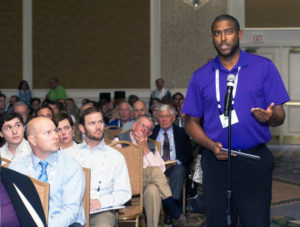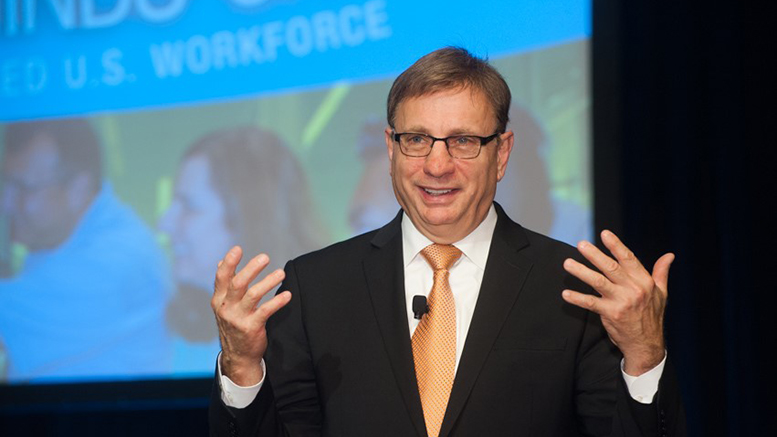Mike Russo set an ambitious goal for the principal investigators of National Science Foundation-funded Advanced Technological Education (ATE) projects and centers who he addressed Monday evening in Washington, D.C.
“How we can really make a difference is if we connect the dots between all our activities and figure out how to scale and sustain them,” said Russo, director and corporate affairs lead of U.S. Government Affairs at GlobalFoundries, the second largest semiconductor chip manufacturer in the world.
Most of the 850 people in the audience at the 2017 ATE Principal Investigators Conference are two-year college educators who have received NSF grants to develop and test their ideas for improving STEM technician education. Sixty-three current students and alumni of ATE programs also attended the three-day conference.
Faculty professional development, lab exercises, STEM career recruitment activities and model degree programs are among the many deliverables that ATE principal investigators have created in collaboration with industry partners during the past 25 years. All ATE materials are freely accessible for others to use; they are archived on a searchable database at atecentral.net.
A great investment
“The ATE program is truly one of the gems in the NSF crown. It is our go-to program when we want to talk about the impact of our work and our funding,” Robin Wright, division director of NSF’s Division of Undergraduate Education, said during the opening plenary.
Her boss at NSF, W. James Lewis, deputy assistant director of the Education and Human Resources Directorate, followed up by saying that the federal science agency values the work done in the ATE program.
“Educating a capable science and technology workforce is imperative for the nation’s security,” Lewis said, adding that the National Science Board recently convened a task force on the skilled technical workforce.
NSF leaders also praised the American Association of Community Colleges (AACC) for its leadership as a long-time partner on the ATE program. AACC receives NSF support to convene the annual conference where principal investigators share information about their programs and learn about emerging technologies and workforce trends.
In her welcoming remarks, Mary S. Graham, AACC board chair and president of Mississippi Gulf Coast Community College, thanked the attendees for work that “matters for the future of our global competitiveness.”
Listen to employers
GlobalFoundries is an industry partner of the Northeast Advanced Technological Education Center (NEATEC), an ATE center that has developed curriculum that community colleges and high schools use to develop the technical workforce at GlobalFoundries and other high-tech employers in upstate New York. NEATEC has also customized some of its community college courses for GlobalFoundries to train new employees to maintain the equipment in the fully automated semiconductor fabrication facility, according to Robert Geer, executive director of NEATEC.
This year, NEATEC responded to employers’ interest in hiring veterans by launching the Fort Drum Soldier for Life – Transition Assistance Program. The one-week course introduces active duty service personnel and veterans to advanced manufacturing technologies and helps them connect their military service skills to civilian jobs.

William Tyson, associate professor at University of South Florida and principal investigator of PathTech LIFE project, asks Mike Russo a question during the opening plenary.
When asked how new ATE principal investigators can work effectively with industry, Russo suggested they begin with “frank discussions” with companies’ human resources personnel. Companies spend money on facilities when they know they have demand for their products; having a workforce in place is part of these calculations, he said.
Russo said to ask, “How can we provide value to stay ahead of the curve?” And then to listen and respond. When employers know that educators are not wasting their time and value their opinion, Russo said, “That will get them to the table.”
Seek guidance
Earlier in the day, Meri Engle, an instructor of computers and digital media at McHenry County College in Illinois, reflected on her ATE experiences for the new cohort of educators selected for MentorLinks, an AACC program that helps colleges start or improve technician education programs. Engle, who was a MentorLinks mentee 10 years ago, said the conference is “one of the best networking opportunities you will ever get.” She urged the new mentees to introduce themselves to people working on ATE initiatives in their fields and to attend sessions on unfamiliar topics in order to learn about cross-discipline opportunities.

